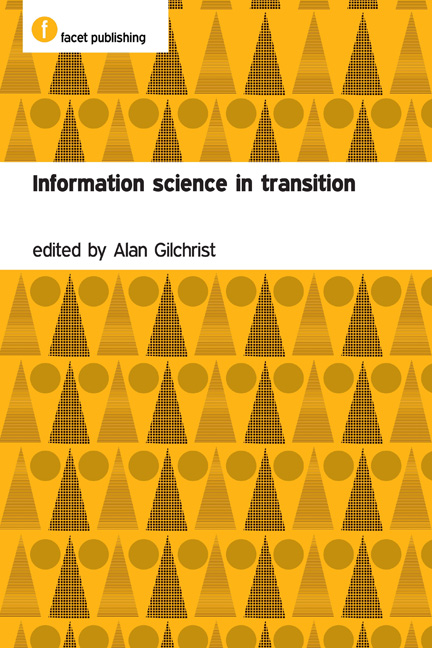Book contents
- Frontmatter
- Contents
- Contributors
- Preface
- Editorial
- Guest Editorial: Meeting the challenge
- 1 Fifty years of UK research in information science
- 2 Smoother pebbles and the shoulders of giants: the developing foundations of information science
- 3 The last 50 years of knowledge organization: a journey through my personal archives
- 4 On the history of evaluation in IR
- 5 The information user: past, present and future
- 6 The sociological turn in information science
- 7 From chemical documentation to chemoinformatics: 50 years of chemical information science
- 8 Health informatics: current issues and challenges
- 9 Social informatics and sociotechnical research – a view from the UK
- 10 The evolution of visual information retrieval
- 11 Information policies: yesterday, today, tomorrow
- 12 The disparity in professional qualifications and progress in information handling: a European perspective
- 13 Electronic scholarly publishing and Open Access
- 14 Social software: fun and games, or business tools?
- 15 Bibliometrics to webometrics
- 16 How I learned to love the Brits
- Index
15 - Bibliometrics to webometrics
Published online by Cambridge University Press: 08 June 2018
- Frontmatter
- Contents
- Contributors
- Preface
- Editorial
- Guest Editorial: Meeting the challenge
- 1 Fifty years of UK research in information science
- 2 Smoother pebbles and the shoulders of giants: the developing foundations of information science
- 3 The last 50 years of knowledge organization: a journey through my personal archives
- 4 On the history of evaluation in IR
- 5 The information user: past, present and future
- 6 The sociological turn in information science
- 7 From chemical documentation to chemoinformatics: 50 years of chemical information science
- 8 Health informatics: current issues and challenges
- 9 Social informatics and sociotechnical research – a view from the UK
- 10 The evolution of visual information retrieval
- 11 Information policies: yesterday, today, tomorrow
- 12 The disparity in professional qualifications and progress in information handling: a European perspective
- 13 Electronic scholarly publishing and Open Access
- 14 Social software: fun and games, or business tools?
- 15 Bibliometrics to webometrics
- 16 How I learned to love the Brits
- Index
Summary
Abstract
Bibliometrics has changed out of all recognition since 1958; becoming established as a field, being taught widely in library and information science schools, and being at the core of a number of science evaluation research groups around the world. This was all made possible by the work of Eugene Garfield and his Science Citation Index. This article reviews the distance that bibliometrics has travelled since 1958 by comparing early bibliometrics with current practice, and by giving an overview of a range of recent developments, such as patent analysis, national research evaluation exercises, visualization techniques, new applications, online citation indexes, and the creation of digital libraries. Webometrics, a modern, fast-growing offshoot of bibliometrics, is reviewed in detail. Finally, future prospects are discussed with regard to both bibliometrics and webometrics.
Introduction
The last 50 years have seen two major technological changes in scholarly publishing and two major changes in the way research can be quantitatively analysed, alongside numerous less significant developments. The two publishing changes are the computerization of the printing process, reducing costs significantly and allowing more journals and books to appear in print; and the conversion of the entire publishing cycle (submission of articles, refereeing and publication) to the internet, allowing faster and possibly cheaper communication throughout. Historically, the first major change for the development of quantitative analysis of academic publishing (bibliometrics) was the creation of the Institute for Scientific Information (ISI, now Thomson Scientific) citation database, which began functioning in 1962 [1, 2] together with associated post-war sociological theory allowing it to be used to assess the impact of scientific work [3]. Since then there has been a continuous increase in the computing power available in universities, which has helped to make increasing numbers of bibliometric analyses possible. The second major development for bibliometrics was the web publishing of an increasingly broad range of research-related documents, from articles to email discussion lists, allowing the creation of a range of new metrics relating to their access and use.
In this article, the focus is on the measurement of science.
- Type
- Chapter
- Information
- Information Science in Transition , pp. 347 - 376Publisher: FacetPrint publication year: 2009



